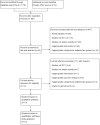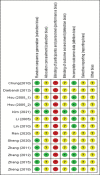Effects of electroacupuncture on obesity: A systematic review and meta-analysis
- PMID: 38215111
- PMCID: PMC10783299
- DOI: 10.1097/MD.0000000000036774
Effects of electroacupuncture on obesity: A systematic review and meta-analysis
Abstract
Background: This systematic review and meta-analysis evaluated the efficacy of electroacupuncture for the treatment of obesity.
Methods: We searched 8 electronic databases for articles published between 2005 and 2021, including only randomized controlled trials (RCTs) in the review. The intervention groups received either electroacupuncture alone or electroacupuncture with standard care, whereas the control groups received sham electroacupuncture, standard care, or no treatment. The primary outcome was the body mass index (BMI), and the secondary outcomes were the body weight (BW), waist circumference (WC), hip circumference, waist-to-hip ratio (WHR), body fat mass, body fat percentage, and adverse effects. Continuous outcome data are presented as mean differences (MDs) with 95% confidence intervals (CIs).
Results: This systematic review and meta-analysis included 13 RCTs involving 779 participants. Results revealed that the BMI (MD: -0.98; 95% CI: -1.35 to -0.61), BW (MD: -1.89; 95% CI: -2.97 to -0.80), WC (MD: -2.67; 95% CI: -4.52 to -0.82), and WHR (MD: -0.03; 95% CI: -0.06 to -0.01) were significantly improved in the intervention groups compared with those in the control groups. Adverse effects were reported in 5 studies. The most commonly used acupoint in the abdomen was ST25, whereas the most commonly used acupoints in other regions were ST36 and SP6 for the treatment of obesity. ST25 was the most commonly used acupoint connected by electroacupuncture.
Conclusion: This systematic review and meta-analysis suggested that electroacupuncture is an effective and safe therapy for simple obesity. To increase the reliability of this study, further detailed, long-term studies should be conducted on the effects of electroacupuncture on obesity.
Copyright © 2024 the Author(s). Published by Wolters Kluwer Health, Inc.
Conflict of interest statement
The authors of this work have nothing to disclose.
Figures













Similar articles
-
Effectiveness of Electroacupuncture for Simple Obesity: A Systematic Review and Meta-Analysis of Randomized Controlled Trials.Evid Based Complement Alternat Med. 2020 Jun 28;2020:2367610. doi: 10.1155/2020/2367610. eCollection 2020. Evid Based Complement Alternat Med. 2020. PMID: 32714399 Free PMC article. Review.
-
Effect of Moxibustion Combined with Other Interventions on Body Weight Reduction in the Treatment of Obesity: A Systematic Review and Meta-Analysis.J Integr Complement Med. 2024 Jun;30(6):576-587. doi: 10.1089/jicm.2022.0826. Epub 2023 Dec 14. J Integr Complement Med. 2024. PMID: 38099954
-
The impact of acupuncture combined with acupoint catgut embedding on simple obesity: A systematic review and meta-analysis.Medicine (Baltimore). 2023 Jul 14;102(28):e34234. doi: 10.1097/MD.0000000000034234. Medicine (Baltimore). 2023. PMID: 37443503 Free PMC article.
-
Acupuncture and related interventions for the treatment of symptoms associated with carpal tunnel syndrome.Cochrane Database Syst Rev. 2018 Dec 2;12(12):CD011215. doi: 10.1002/14651858.CD011215.pub2. Cochrane Database Syst Rev. 2018. PMID: 30521680 Free PMC article.
-
The Effectiveness of Acupoint Catgut Embedding Therapy for Abdominal Obesity: A Systematic Review and Meta-Analysis.Evid Based Complement Alternat Med. 2019 Jun 23;2019:9714313. doi: 10.1155/2019/9714313. eCollection 2019. Evid Based Complement Alternat Med. 2019. PMID: 31341504 Free PMC article. Review.
Cited by
-
Electroacupuncture Combined with Press Needles Alleviates Simple Obesity via VEGF-C/VEGFR-3/PI3K/AKT Signaling Pathway.Obes Facts. 2025 Mar 19:1-16. doi: 10.1159/000545330. Online ahead of print. Obes Facts. 2025. PMID: 40107254 Free PMC article.
References
-
- Kolotkin RL, Meter K, Williams GR. Quality of life and obesity. Obes Rev. 2001;2:219–29. - PubMed
-
- Chooi YC, Ding C, Magkos F. The epidemiology of obesity. Metabolism. 2019;92:6–10. - PubMed
-
- Lavie CJ, Milani RV, Ventura HO. Obesity and cardiovascular disease: risk factor, paradox, and impact of weight loss. J Am Coll Cardiol. 2009;53:1925–32. - PubMed
-
- Fontaine KR, Redden DT, Wang C, et al. Years of life lost due to obesity. JAMA. 2003;289:187–93. - PubMed
Publication types
MeSH terms
LinkOut - more resources
Full Text Sources
Research Materials
Miscellaneous

